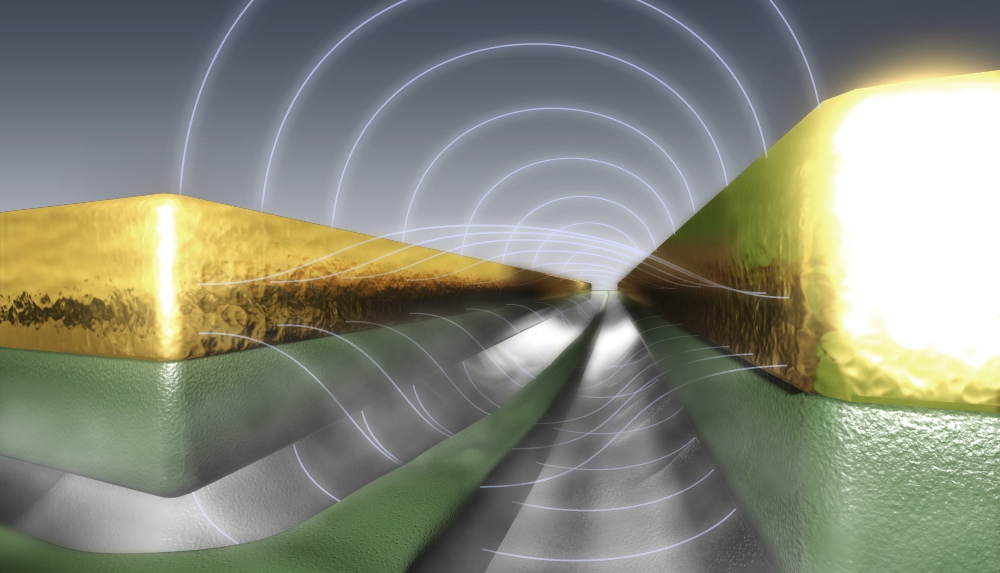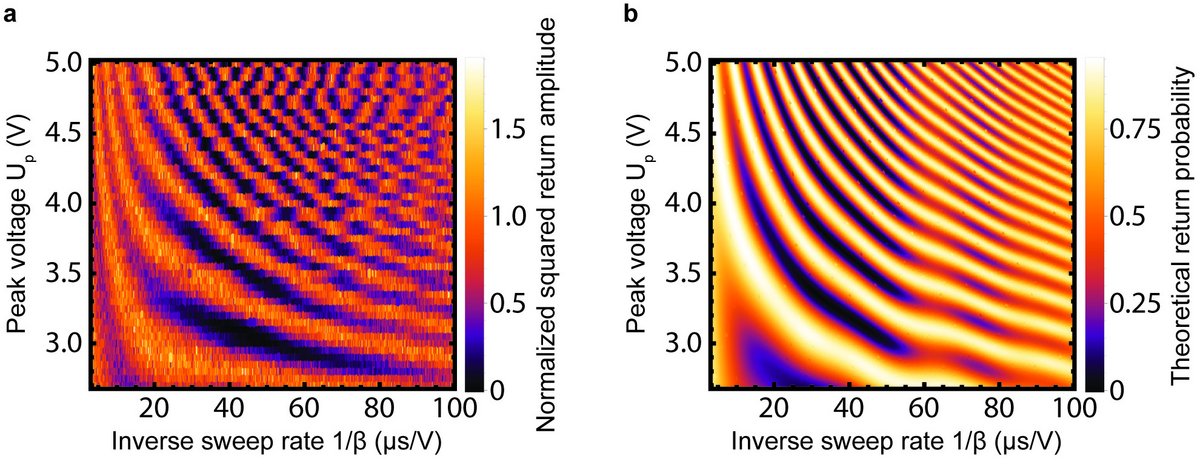
A07 - Dielectric control of high Q nanomechanical resonators
Funding period: 04/2014 – 12/2019
Principal investigator: Eva Weig
Scientific staff: Maximilian Bückle, Juliane Doster, Katrin Gajo, Jana Huber, Anh Tuan Le, Maximilian Seitner
The aim of this project is to explore high Q nanomechanical resonators as future linking elements in hybrid nanodevices. It focusses on freely suspended, doubly clamped silicon nitride strings under strong inherent tensile stress. These devices exhibit unusually high mechanical room temperature quality factors of several 100,000 when operated in moderate vacuum. A well-controlled platform for the actuation, manipulation and detection of nanomechanical vibration combines these high Q nanoresonators with dielectric transduction based on electrically induced gradient fields [Unterreithmeier 2009, Faust 2012, Rieger 2012]. Besides continuously improving this nanomechanical platform by engineering systems with larger quality factors and by refining the available control techniques, e.g. by additional metallization [Seitner 2014] or by coupling to superconducting circuitry [Pernpeintner 2014], we particularly focus on the coupled dynamics of the in- and out-of-plane vibrational modes of the nanostrings.
The high mechanical quality factor of the strings is directly tied to the strong tensile pre-stress which increases the mechanical energy stored in the resonator vibration. In previous years, we‘ve been able to establish that the quality factor of the investigated amorphous silicon nitride (SiN) strings with a stress of approx. 1 GPa is limited by the dissipation induced by configurational defects which are well-known in glassy materials [Faust 2014], and not by the radiation of vibrational energy into the clamping area [Rieger 2014]. Hence, a future increase of the quality factor will require reducing the number of defects in the stressed string. One possible solution is the development of a crystalline rather than an amorphous material platform for strongly pre-stressed nanostring resonators. In recent years, we have explored epitaxially grown In1-xGaxP heterostructures as a novel material for nanomechanics, in which the tensile stress can be adjusted by means of the gallium content x. Pseudomorphic growth of crystalline films with a thickness of approx. 100 nm and an orientation-dependent tensile stress of up to 700 MPa has been demonstrated for x=59% [Bückle 2018]. Quality factors in the range of 100,000 are observed, however, a detailed analysis of the limiting mechanisms is ongoing.
Finite element simulations with COMSOL Multiphysics have revealed additional insights into the dielectric resonance frequency tuning as well as the mode coupling of in-plane and out-of-plane modes, that both result from the inhomogeneous electric field used to dielectrically control the resonators. Even more, strain-induced strong coupling between adjacent string resonators sharing an engineered clamping point has been revealed [Gajo 2017].
Dielectric control of high quality factor nanostrings enables to coherently control the dynamics of the system. A prominent example is the nanomechanical two mode system formed by the two strongly coupled modes of a single string which, in many respects, represents a model system mimicking the coherent dynamics of its quantum counterpart. Following our previous work [Faust 2012 (Phys. Rev. Lett. 109), Faust 2013], classical Stückelberg interferometry has shed light on the role of classical coherence in nanomechanics [Seitner 2016a]. Besides demonstrating classical interference of two coupled mechanical modes, the system yields interesting insight into finite time effects in Stückelberg interferometry [Seitner 2016b].

Finally, the nonlinear dynamics of nanomechanical resonators reveals unexplored territory. Using stressed silicon nitride membranes as a model system, a collaboration between our group with the group of Elke Scheer has yielded insights into a previously undescribed spatial modulation of the membrane’s eigenmodes which goes along with a localization of overtones [Yang 2019].
For further information please also refer to the group website: AG Weig
List of publications
2020
- J. S. Huber, G. Rastelli, M. J. Seitner, J. Kölbl, W. Belzig, M. I. Dykman, E. M. Weig
Spectral Evidence of Squeezing of a Weakly Damped Driven Nanomechanical Mode
Phys. Rev. X 10, 021066 (2020) - DOI: 10.1103/PhysRevX.10.021066 - K. Gajo, G. Rastelli, and E. M. Weig
Tuning the nonlinear dispersive coupling of nanomechanical string resonators
Phys. Rev. B 101, 075420 (2020) - DOI: 10.1103/PhysRevB.101.075420
2019
- Juliane Doster, S. Hoenl, H. Lorenz, P. Paulitschke, and Eva M. Weig
Collective dynamics of strain-coupled nanomechanical pillar resonators
Nature Communications 10, 5246 (2019) - DOI: 10.1038/s41467-019-13309-9 - Mark I. Dykman, Gianluca Rastelli, Mike L. Roukes, Eva M. Weig
Resonantly induced friction and frequency combs in driven nanomechanical systems
Phys. Rev. Lett. 122, 254301 (2019) - DOI: 10.1103/PhysRevLett.122.254301 - Fan Yang, Felix Rochau, Jana S. Huber, Alexandre Brieussel, Gianluca Rastelli, Eva M. Weig, Elke Scheer
Spatial Modulation of Nonlinear Flexural Vibrations of Membrane Resonators
Phys. Rev. Lett. 122, 154301 (2019) - DOI: 10.1103/PhysRevLett.122.154301
2018
- Maximilian Bückle, Valentin C. Hauber, Garrett D. Cole, Claus Gärtner, Ute Zeimer, Jörg Grenzer, and Eva M. Weig
Stress control of tensile-strained In1−xGaxP nanomechanical string resonators
Appl. Phys. Lett. 113, 201903 (2018) - DOI: 10.1063/1.5054076
2017
- Katrin Gajo, Simon Schüz, and Eva M. Weig
Strong 4-mode coupling of nanomechanical string resonators
Appl. Phys. Lett. 111, 133109 (2017) - DOI: 10.1063/1.4995230 - Maximilian J. Seitner, Mehdi Abdi, Alessandro Ridolfo, Michael J. Hartmann, and Eva M. Weig
Parametric oscillation, frequency mixing, and injection locking of strongly coupled nanomechanical resonator modes
Phys. Rev. Lett. 118, 254301 (2017) - DOI: 10.1103/PhysRevLett.118.254301 - M. J. Seitner, H. Ribeiro, J. Kölbl, T. Faust, J. P. Kotthaus, and E. M. Weig
Finite time Stückelberg interferometry with nanomechanical modes
New. J. Phys. 19, 033011 (2017) - DOI: 10.1088/1367-2630/aa5a3f609.05023
2016
- M. J. Seitner, H. Ribeiro, J. Kölbl, T. Faust, J. P. Kotthaus, and E. M. Weig
Classical Stückelberg interferometry of a nanomechanical two-mode system
Phys. Rev. B 94, 245406 (2016) - DOI: 10.1103/PhysRevB.94.245406
2014
- M. J. Seitner, K. Gajo, and E. M. Weig
Damping of metallized bilayer nanomechanical resonators at room temperature
Appl. Phys. Lett. 105, 213101 (2014) - DOI: 10.1063/1.4902430 - M. Pernpeintner, T. Faust, F. Hocke, J. P. Kotthaus, E. M. Weig, H. Huebl, R. Gross
Circuit electromechanics with a non-metallized nanobeam,
Appl. Phys. Lett. 105, 123106 (2014) - DOI: 10.1063/1.4896419 - T. Faust, J. Rieger, M. J. Seitner, J. P. Kotthaus, E. M. Weig
Signatures of two-level defects in the tem perature-dependent damping of nanomechanical silicon nitride resonators
Phys. Rev. B 89, 100102(R) (2014) - DOI: 10.1103/PhysRevB.89.100102 - J. Rieger, A. Isacsson, M. J. Seitner, J. P. Kotthaus, E. M. Wei
Energy losses of nanomechanical resonators induced by atomic force microscopy-controlled mechanical impedance mismatching
Nature Comm. 5, 3345 (2014) - DOI: 10.1038/ncomms4345.
2009 - 2013 (foundational preceding work):
- T. Faust, J. Rieger, M. J. Seitner, J. P. Kotthaus, E. M. Weig
Coherent control of a classical nanomechanical two-level system
Nature Phys. 9, 485 (2013) - DOI: 10.1038/nphys2666 - J. Rieger, T. Faust, M. J. Seitner, J. P. Kotthaus, E. M. Weig
Frequency and Q-factor control of nanomechanical resonators
Appl. Phys. Lett. 101, 103110 (2012) - DOI: 10.1063/1.4751351 - T. Faust, J. Rieger, M. J. Seitner, P. Krenn, J. P. Kotthaus, E. M. Weig
Non-adiabatic dynamics of two strongly coupled nanomechanical resonator modes
Phys. Rev. Lett. 109, 037205 (2012) - DOI: 10.1103/PhysRevLett.109.037205 - T. Faust, P. Krenn, S. Manus, J. P. Kotthaus, E. M. Weig
Microwave cavity-enhanced transduction for plug and play nanomechanics at room temperature
Nature Comm. 3, 728 (2012) - DOI: 10.1038/ncomms1723 - Q. P. Unterreithmeier, E. M. Weig, J. P. Kotthaus
Universal transduction scheme for nanomechanical systems based on dielectric forces
Nature 458, 1001 (2009) -DOI: 10.1038/nature07932
